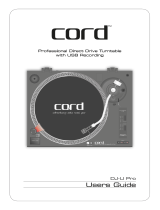
2
Consignes de sécurité
Bien que ce produit soit conçu pour une utilisation sûre, une utilisation
incorrecte peut entraîner un accident. Pour garantir la sécurité,
respectez tous les avertissements et consignes lors de l’utilisation du
produit.
Consignes relatives au produit
Avertissement:
• N’utilisez pas un autre câble d’alimentation que celui fourni. Vous
risqueriez de provoquer un incendie, un choc électrique, une
détérioration ou un dysfonctionnement.
• Cessez d’utiliser le produit et débranchez le câble d’alimentation
si le produit commence à dysfonctionner, émet de la fumée, une
odeur, de la chaleur, un bruit indésirable ou présente d’autres signes
de détérioration. Dans un tel cas, contactez votre distributeur local
Audio-Technica. Poursuivre l’utilisation du produit peut entraîner un
incendie ou des dommages.
• Ne placez pas de flammes nues (telles que des bougies allumées) sur
le produit.
• Pour éviter tout choc électrique, dysfonctionnement ou incendie,
ne démontez pas, ne modifiez pas le produit et ne tentez pas de le
réparer.
• Pour éviter tout choc électrique, dysfonctionnement ou incendie,
n’exposez pas le produit à un fort impact.
• Pour éviter tout choc électrique ou blessure, ne manipulez pas le
produit avec les mains humides.
• Pour éviter tout choc électrique, dysfonctionnement ou incendie,
n’exposez pas le produit à des gouttes ou éclaboussures humides.
• Pour éviter tout choc électrique, dysfonctionnement ou incendie, ne
placez pas de corps étrangers tels que matières combustibles, métal
ou liquide dans le produit.
• Pour éviter tout incendie ou blessure par surchauffe, ne recouvrez
pas le produit de moquette ou tissu.
• Pour éviter tout accident ou incendie, rangez le sac en plastique
fourni avec le produit hors de portée des jeunes enfants et éloigné
des sources de chaleur.
• Placez le produit suffisamment près de la prise secteur pour pouvoir
saisir aisément la fiche du câble d’alimentation à tout moment. En
cas d’urgence, débranchez rapidement la fiche du câble d’alimentation
du produit.
• Branchez le produit à une prise secteur de classe
Ⅰ
avec mise à la
terre de protection.
Attention:
• N’installez pas le produit sur une surface instable pour éviter les
blessures ou les détériorations en cas de chute du produit.
• Pour éviter tout accident ou incendie dû à l’accumulation de
chaleur, n’installez pas le produit dans un lieu mal aéré. Ménagez
suffisamment d’espace autour du produit pour que la chaleur se
diffuse s’il est installé dans une baie.
• Pour éviter tout choc électrique, dysfonctionnement ou incendie, ne
stockez dans un endroit où il est exposé aux rayons directs du soleil
ni dans un lieu chaud, humide ou poussiéreux.
• Ne placez pas d’objets remplis de liquide, tels que vase, sur le produit
pour éviter tout choc électrique, dysfonctionnement ou, dans le pire
des cas, un incendie.
• N’utilisez pas de substances chimiques telles que benzine, diluant
ou nettoyant pour contacts électriques afin d’éviter dommages ou
dysfonctionnement.
Pour les clients aux États-Unis
Notice UL/CSA
Consignes de sécurité
1. Lisez ces instructions.
2. Conservez ces instructions.
3. Respectez tous les avertissements.
4. Suivez toutes les instructions.
5. N’utilisez pas cet appareil à proximité de l’eau.
6. Nettoyez uniquement avec un chiffon sec.
7. Ne bloquez aucun aérateur. Installez le produit conformément aux
instructions du fabricant.
8. N’installez pas le produit à proximité de sources de chaleur
telles que radiateurs, chauffage, cuisinières ou autres appareils
(notamment amplificateurs) qui produisent de la chaleur.
9. Ne déjouez pas l’objectif de sécurité de la fiche polarisée ou avec
mise à la terre. Une fiche polarisée compte deux lames, l’une plus
large que l’autre.
Une fiche avec mise à la terre compte deux lames plus une
troisième broche de mise à la terre. La lame large ou la troisième
broche est présente pour votre sécurité. Si la fiche fournie ne s’insère
pas dans votre prise, consultez un électricien pour remplacer la prise
obsolète.
10. Protégez le cordon d’alimentation des pas ou des pincements,
particulièrement au niveau des fiches, des réceptacles de service et
du point où il sort de l’appareil.
11. Utilisez uniquement les raccords/accessoires spécifiés par le
fabricant.
12. Utilisez uniquement le chariot, socle, trépied, support ou table
spécifié par le fabricant ou vendu avec l’appareil. Lorsque vous
utilisez un chariot, déplacez la combinaison chariot/appareil avec
précaution pour éviter tout accident dû à un renversement.
13. Débranchez cet appareil pendant les orages ou lorsqu’il demeure
inutilisé pendant une période prolongée.
14. Réservez toutes les opérations de réparation à du personnel qualifié.
Une réparation est nécessaire lorsque l’appareil a été endommagé
d’une quelconque manière, comme par exemple lorsque le cordon
d’alimentation est endommagé, si du liquide a été renversé ou si
des objets sont tombés dans l’appareil, s’il a été exposé à la pluie
ou à l’humidité, s’il ne fonctionne pas normalement ou a chuté.
Attention:
Pour éviter tout choc électrique, n’ouvrez pas le boîtier.
Il ne contient aucune pièce réparable par l’utilisateur. Les réglages
internes doivent être réservés à des professionnels qualifiés. Réservez
toutes les opérations de réparation à du personnel qualifié.
Attention: Pour éviter tout choc électrique, n’utilisez pas cette prise
polarisée avec une rallonge électrique, un réceptacle ou une autre
prise si les lames ne s’insèrent pas entièrement pour les protéger de
toute exposition.
Le symbole d’éclair, avec «l’éclair présentant une flèche
dans un triangle équilatéral, est destiné à alerter l’utilisateur
de la présence de «tension dangereuse» non isolée à
l’intérieur du boîtier du produit, d’une ampleur constituant
un risque de choc pour les personnes».
Le symbole de point d’exclamation, avec «le point
d’exclamation dans un triangle équilatéral est destiné
à alerter l’utilisateur de la présence d’instructions de
fonctionnement et d’entretien (réparation) importantes
dans la documentation qui accompagne le produit».
ATTENTION
RISQUE DE CHOC ÉLECTRIQUE
NE PAS OUVRIR




















